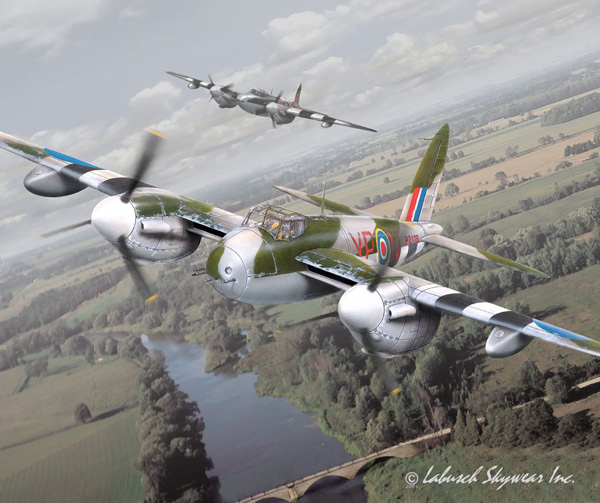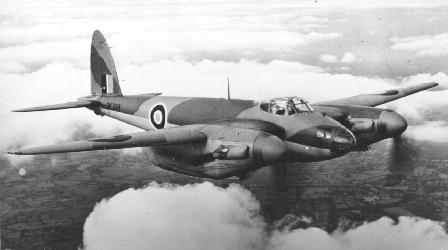
|
 |
De Havilland Mosquito |
 |
 |
 |
 |
 |
|---|---|---|---|---|---|---|---|
 |
 |
 |
 |
 |
|||
 |
||
|
By late 1942 the Mosquito was becoming operational in ever increasing numbers, and its unique qualities of very high speed and long range were clearly ideal for many missions. (Graphic courtesy of www.skywear.com) |
| It is one of the paradoxes of aircraft development that some of the world's greatest aeroplanes have achieved their fame doing jobs other than the one they were originally designed for. No better example of this could be found than the Mosquito, which, conceived as a bomber, became one of the war's most potent fighters. More than this, indeed, it was probably the most successfully versatile of any twin-engined type built between 1939 and 1945. It excelled in all the widely varied roles. Its duties included the duties of low-level and high-attack day and night bomber, long-range photo-reconnaissance, mine layer, pathfinder, high-speed military transport, long-range day and night fighter, and fighter-bomber. It served in Europe, the Middle and Far East and on the Russian front. In fact, the ubiquitous Mosquito reigned supreme among General Purpose types. Of the grand total of 7,781 Mosquitos built, 6,710 were delivered during the war years. |
|
On March 1, 1940, the first contract was placed, for fifty D.H.98 bombers
(including prototypes) to be built to specification B.1/40 which had been
written around De Havilland's proposals, and the name Mosquito was approved.
The period was an inauspicious one for the initiation of so radical a design.
With the war going against Britain, the tendency was to concentrate on
existing designs. With the fall of France and the Dunkirk evacuation, the
Mosquito was actually dropped from Ministry of Aircraft Production programs
at one stage, setting back the ordering of materials. But permission to
proceed was later given again, although De Havillands were told that their
Tiger Moth and
Oxford
production were to take priority. Had it not been that the Mosquito used
"non-strategic"
molded plywood
for its construction, it might well never have been reinstated.
Construction of the prototype was pressed ahead through the difficult months of 1940. While the "Battle of Britain" was fought out overhead, bombs fell within a mile of the Hatfield factory, on one day in every five. Nearly 25 per cent of the working hours, day and night, were spent in air-raid shelters. Despite all these vicissitudes, the prototype (W4050) made its first flight on November 25, 1940, only ten months and twenty-six days after detailed design work had commenced. The pilot was Geoffrey De Havilland, Jr. Meanwhile, inevitably, requirements had been changing. There was some loss of confidence in the high-speed bomber, while the heavily armed long range fighter grew in favor. The contract was therefore changed to twenty bombers and thirty fighters, necessitating the modification of a number of parts already manufactured. Construction of a fighter prototype proceeded at Salisbury Hall, London Colney, which served as a dispersal for the Hatfield design office and experimental shop. Two days before this prototype (W4052) was ready to fly, a German agent was dropped by parachute close to Salisbury Hall, in plain clothes and with a portable radio. He was captured next day, and the day after, May 15, 1941, Geoffrey De Havilland flew the fighter prototype from a 450-yard field beside the shed in which it had been built.

The prototype made its first flight on November 25, 1940. This was only ten months and twenty-six days after detailed design work had commenced. The first Mosquito sortie was made on September 20, 1941, when a single aircraft made a reconnaissance flight over France. At home, the Mosquito night fighter, carrying A.I Mk IV airborne radar, began to take over from the Bristol Blenheim. By late 1942, the Mosquito was becoming operational in ever increasing numbers, and its unique qualities of very high speed and long range were clearly ideal for a particular mission then being planned. It had been decided that an attack should be made on the German Gestapo headquarters in Oslo, Norway, which contained records of members of underground resistance organizations. Such a mission would, if successful, help protect those who were supplying Britain with secret information. Therefore, on September 25, 1942, Mosquitos carried out a long range attack on the HQ, accurately bombing the building and then returning home at high speed. The basic fighter Mosquito introduced into squadron service in 1942 was the N.F.Mk.II, equipped primarily as a night-fighter and used for home defense alongside the Bristol Beaufighter. Its armament comprised four 20 mm cannon in the front fuselage belly and four Browning .303 in. machine-guns in the extreme nose. It carried Aircraft Interception (AI) Mk.IV or AI Mk.V "arrowhead" radar and a G-45 machine gun. Its matt-black overall finish, incidentally, reduced its maximum speed by 16 mph. Power was provided either by two Merlin 21 engines giving 1,280 hp for takeoff and 1,480 hp at 12,250 feet, or two Merlin 23 engines giving 1,390 hp for takeoff and the same maximum power at 12,250 feet. On the night of May 28-29, 1942, Mosquito N.F.IIs scored their first "probable," and in the following three years, Mosquito night-fighters racked up a score of approximately 600 enemy aircraft over the British Isles, and also destroyed 600 flying bombs in a two month period. They later operated in the bomber support role, their task being to defend the main heavy bomber streams over enemy territory. Of the 466 Mark II Mosquito fighters produced, some of the later aircraft had day-fighter finish and, with the AI radar removed, operated over Malta, Italy, Sicily and North Africa from the end of 1942 onwards. Operational experience with the Mosquito II in its day-fighter and intruder roles led to the development of the F.B.VI, a potent fighter-bomber which came into service during the early months of 1943. It had been discovered that the Mosquito was able to accommodate a much greater warload than that for which it had been designed, and thus the Mark VI, with a strengthened wing for external loads which later became known as the "basic" wing, carried a full complement of cannon and machine-guns, two 500 lb. bombs in the rear half of the bomb bay (the front half containing the cannon breeches) and two 500 lb. bombs under the wings. Actually, the full 2,000 lb. bomb load was only carried by the Mark VI Series 2 which took advantage of the 1,620 hp available from the Merlin 25 for takeoff, the first 300 machines being F.B.VI Series 1 Mosquitos with Merlin 21s or 23s and carrying two 250 lb. bombs internally.

The prototype night fighter with a circular segmented air brake installation. Later, in mid-1943, the Mosquito FB Mk VI was becoming operational. As well as the usual RAF duties, it was used by Coastal Command as an anti-shipping aircraft, armed with eight 60 lb. rocket projectiles. More unusual weapons carried by some Mosquitos included a 57 mm cannon for ground attack (this devastating gun was capable of destroying any armored vehicle), and the 4,000 lb. 'block-buster' bomb. Even with this bomb on board, the Mosquito could out fly most German night fighters, and on numerous occasions it attacked far-off Berlin and German V1 flying-bomb sites. An entirely separate line of development from the Mosquito Night Fighter (NF) II produced a series of night-fighting variants which were primarily used for home-defense purposes. The first of these was the NF XII, plans to produce the NF VI with Merlin 21s and the "basic" wing, and the NF X with Merlin 61s and the "basic" wing, having been abandoned. The Mosquito NF XII became the first British aircraft to carry centimetric AI radar. This form of radar introduced the spinning-dish scanner with greatly improved performance compared with the earlier "arrow-head" type, but it resulted in some singularly unattractive nose contours on the aircraft in which it was carried. The centimetric radar supplanted the four machine guns in the fuselage nose, reducing the armament to four 20 mm Hispano cannon. To expedite its service debut, the Mosquito XII was based directly on the Mark II and ninety-seven machines were converted by the installation of the new radar. Of the Mosquitos built in Canada, the F.B.26 was one of the chief variants, the design of which was based upon that of the F.B.VI. With the same armament as its British counterpart, it had Packard Merlin 225 engines and weighed 21,473 lbs. The sole F.B.24 was similar but had Packard Merlin 69s, while the F.B.21, of which only three were built, had Packard Merlin 31 or 33 engines. Australian production was also based initially on the fighter-bomber, the F.B.40 being similar to the F.B.VI but having Packard Merlin 31 (first hundred production machines) or 33 (last seventy-eight) engines. One F.B.40 was re-engined with Packard Merlin 69s and redesignated Mosquito F.B.42, but no production of this version was undertaken. No fewer than twenty-seven different versions of the Mosquito went into service during the war years, and some of the most spectacular operations of the air war stood to its credit. The Mosquito carried phenomenal loads over extremely long distances, performing feats out of all proportion to the specification originally envisaged by its designers. In short, the Mosquito was an outstanding warplane on every count. Mosquitos were active on D-Day, and right up to the end of the war. Others were license built in Canada and Australia. Production did not end in Britain until late 1950.

A De Havilland Mosquito Mk. B-4. |
| Specifications: | |
|---|---|
| De Havilland D.H.98 Mosquito N.F.XIX | |
| Dimensions: | |
| Wing span: | 54 ft. 2 in. (16.5 m) |
| Length: | 41 ft. 2 in. (12.54 m) |
| Height: | 15 ft. 3 in. (4.64 m) |
| Weights: | |
| Empty: | 15,970 lb (7,243 kg) |
| Normal: | 20,600 lb. (9,344 kg) |
| Max Gross: | 21,750 lb. (9,865 kg) |
| Performance: | |
| Maximum Speed: | 378 mph (608 km/h) @ 13,200 ft. (4,023 m) |
| Cruise Speed: | 295 mph (474 km/h) @ 20,000 ft. (6,096 m) |
| Service Ceiling: | 28,000 ft. (8,534 m) |
| Range: |
1,400 miles (2,253 km) (with 453 Imp. gal.) 1,905 miles (3,065 km) (with 616 Imp. gal., including two 50-gal. droptanks) |
| Powerplant: | |
|
Two Rolls-Royce Merlin 25 twelve-cylinder 60ø Vee
liquid-cooled engines each providing 1,620 hp (1,208 kw) @ takeoff and 1,500 hp (1,118 kw) @ 9,500 ft. (2,895 m). | |
| Armament: | |
| Four 20-mm. British Hispano cannon | |
© The Aviation History On-Line Museum. All rights reserved.
Created Novenber 27, 2001. Updated Octobr 17, 2013.